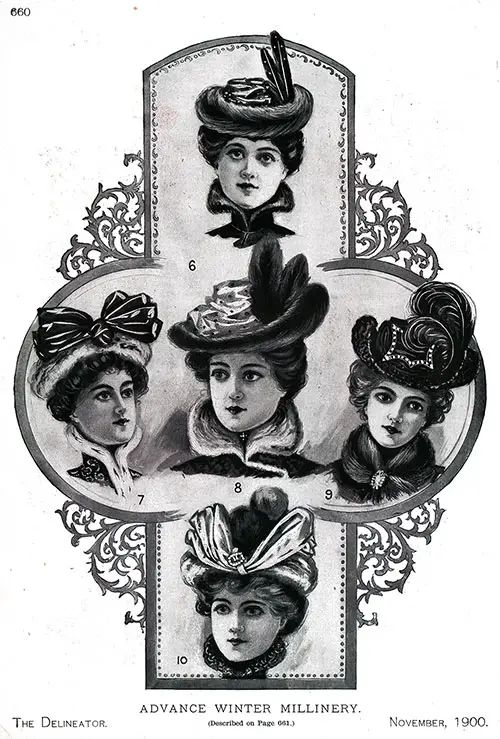Ladies Advanced Winter Hat Fashions - Plate 2 - November 1900
Beautifully illustrated Plate of advanced winter hat fashions for November 1900 offers exquisite descriptions of the latest styles and fabrics used in the creations of chilly winter headwear for women.

Illustration 2: Advance Winter Hat Fashions
Figure No. 6. (Top Row, Center) — This stylish turban is composed of a low, flat crown, over which cloth is expertly draped, and a rolling brim that is covered with mink.
Two speckled quills at the left side give becoming height to the mode, which is particularly suitable for wear with a tailored costume of cloth of the color used in the crown. Castor cloth and mink would be an attractive combination.
Figure No. 7. (Middle Row, Left) — Hats of chinchilla are always lovely accompaniments to smart jackets trimmed with this silvery fur. This attractive toque of chinchilla will be becoming when the hair is worn in Pompadour style.
The low crown is in a bell shape, and the brim is rolling. A large black velvet bow arranged in front spreads out at each side, producing an approved effect. The velvet bow could be of some becoming color if a less somber outcome is desired.
Figure No. 8. (Middle Row, Center) — This modish hat, in which dotted Louisine and mink are associated, will be found almost universally becoming.
The fashionably low crown is formed of Louisine having a white ground polka-dotted with brown. The brim is of mink and flares at the left side.
Two mink tails disposed at the left side supply the only ornamentation to the mode, which is particularly suited to wear with a brown tailor suit and a boa and muff of mink.
Figure No. 9. (Middle Row, Right) — This modified walking shape is made of Persian lamb, with trimmings of panne, plumes and a jet buckle. The brim of the hat is straight over the eyes, gracefully rolling at each side, and the crown is low and flat.
There is a soft drapery of the panne around the crown, and the buckle is adjusted in front. Two black plumes at the left side complete the adornment of this smart model. Sable, mink, and chinchilla would develop a stylish flat of this type.
Figure No. 10. (Bottom Row, Center) — Silver-gray panne and chinchilla were associated in this dressy little toque, of which the crown is low and the brim round and roiling. The crown is made of panne, chinchilla being used to cover the brim.
Panne cleverly disposed forms the trimming and is arranged in soft loops at each side of the front and caught at the center on the brim with a buckle. Two pompons of black and white feathers are placed in front between the loops of velvet.
“Early Winter Millinery: Inscriptions of Millinery Plate 2: Advance Winter Millinery,” in The Delineator: An Illustrated Magazine of Literature and Fashion, Paris-London-New York-Toronto: The Butterick Publishing Co. Ltd., Vol. LXI, No. 5, November 1900, p. 660-661.
Editor's Note: Some terminology used in the description of women's clothing during the 1800s and early 1900s has been changed to reflect more modern terms. For example, a women's "Toilette" -- a form of costume or outfit has an entirely different common meaning in the 21st century. Typical terms applied to "toilette" include outfit, ensemble, or costume, depending on context.
Note: We have edited this text to correct grammatical errors and improve word choice to clarify the article for today’s readers. Changes made are typically minor, and we often left passive text “as is.” Those who need to quote the article directly should verify any changes by reviewing the original material.

